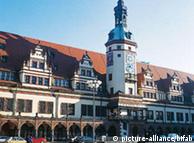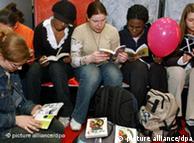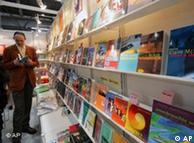萊比錫 (德語:Leipzig; 索布語:Lipzk) 是德國薩克森州最大的城市,德國東部的第二大城市。位於薩克森州萊比錫盆地中心。它的古稱是Lipsia或Lipzk,來源於斯拉夫語Липа,意思是「酸橙樹」或「椴樹」。歌德稱它為「小巴黎」。
在1015年的一個文件中,第一次提到「萊比錫城堡」的名字。1165年這裡建立了一個市場。這個日期現在被認為城市的建城日,以後每年都要舉行兩次大的商業性集會;1268頒發的特許狀,使萊比錫集市更加規範化,成為博覽會的雛形。
1409年,萊比錫大學成立,萊比錫開始了成為出版業中心的的發展歷程,此後又成為1912年建立的德國國家圖書館的所在地。從1497年起萊比錫被允許開展博覽會。1507年,神聖羅馬帝國皇帝馬克西米連一世下詔,規定萊比錫周圍15德里的範圍內享有集市優先權。從此萊比錫的貿易集市地位日益突出,最終發展成今日世界聞名的博覽會之城。萊比錫圖書博覽會是世界最大的圖書交易及博覽會之一。約翰·塞巴斯蒂安·巴赫於1723年至1750年在萊比錫的聖托馬斯教堂工作。
1813年,萊比錫成為拿破崙戰爭中著名的萊比錫戰役(又稱「民族戰役」)的主戰場,拿破崙的軍隊被普魯士,奧地利和俄國的聯軍擊敗。為紀念這次戰役100周年, 德國於1913年建立了「民族之戰紀念碑」(de:Völkerschlachtdenkmal)。
萊比錫曾經是德國第一條長途鐵路的終點站,該鐵路建於1838年,從萊比錫到薩克森首府德累斯頓),萊比錫後來成為中歐鐵路運中的重要樞紐。萊比錫車站的建築也享有聲譽,現在已成為歐洲最大的客運車站。
1863年,斐迪南·拉薩爾在萊比錫成立了德國的第一個工人政黨——全德工人聯合會(Allgemeiner Deutscher Arbeiterverein)。1920年代,法本化學康采恩在萊比錫附近的洛伊納(de:Leuna)建立了龐大的化學及石油工業綜合體。第二次世界大戰期間,萊比錫遭到盟軍的猛烈轟炸,1945年4月20日被美軍第60步兵師佔領。
從1952年到1990年,萊比錫是德意志民主共和國萊比錫專區的首府。1989年爆發了針對昂納克政權大規模的群眾抗議活動。德國統一後,萊比錫發展十分迅速,現在居民已超過五十萬。
萊比錫是申請主辦2012年奧運會的城市之一,但是沒有通過第一輪選拔。
Book Fair | 13.03.2008
Leipzig Celebrates Long Literary History
Home to one of the world's oldest book fairs, and a famous German creative writing program, the city of Leipzig is slowly returning to its literary glory.
Leipzig hosted its first book fair in the 17th century and has earned itself a name as one of Europe's premier ink-smudged cities. Now, nearly 400 years later, the city once again plays host to the Leipzig Book Fair, held this year from March 13-16, 2008.
"Before the Second World War, Leipzig was known as the headquarters of the German book trade," said Sabine Knopf, author of the book, "Der Leipziger Gutenbergweg" ("Leipzig's Gutenberg Path"), which traces the city's literary history.
With its very own "Graphics Quarter" neighborhood, Knopf explained, the city served as a model for English publishers and booksellers in the 1920s, providing an organizational pattern that's spread throughout the world. By 1930, the city with 230,000 residents had 436 publishers, 277 printers, and 69 bookstores. One in 10 residents worked in the book industry.
 Bildunterschrift: Großansicht des Bildes mit der Bildunterschrift: City Hall remains a symbol of Leipzig's grand past
Bildunterschrift: Großansicht des Bildes mit der Bildunterschrift: City Hall remains a symbol of Leipzig's grand past
All that changed once the Third Reich rose to power. Many Jewish-owned publishing houses were closed. The Graphics Quarter was destroyed during World War II bombing raids, burning along with it more than a million books. The city that had influenced publishing around the world no longer had a book trade of its own.
Struggling to re-establish itself
After the war ended, Leipzig struggled to return to its publishing heritage.
"Many publishing houses didn't receive licenses after 1945," said Knopf. "Publishers either moved away, closed, or were ousted."
Still, not all was lost. The renowned German creative writing program "Deutsches Literaturinstitut" -- known in the former East Germany as the Johannes R. Becher Institut -- was founded in Leipzig in 1955. The city's publishing industry likewise slowly began to re-emerge under communist rule.
Though German reunification saw many publishing houses close, Leipzig has since worked diligently to regain some of its former glory and to establish itself as a home for new literature. Training programs for booksellers were formed and small publishers began to develop in the city. Young authors moved there as students of the Deutsches Literaturinstitut.
The Leipzig Book Fair, reorganized in 1991 after a decades-long hiatus, also contributed to the renaissance. While focusing primarily on making German and central and eastern European literature accessible to the public, the book fair also seeks to highlight the city's literary traditions while giving back to the community.
Leipzig Reads
 Bildunterschrift: Großansicht des Bildes mit der Bildunterschrift: The Leipzig Book Fair appeals to old and young alike
Bildunterschrift: Großansicht des Bildes mit der Bildunterschrift: The Leipzig Book Fair appeals to old and young alike
One of the ways the book fair gives back is by concurrently running the literary festival "Leipzig Reads." Alongside the more than 2,300 exhibitions from 36 countries set up at the fairgrounds, the separate festival features 1,900 author readings in 300 locations throughout the city. From traditional spots like cafes and bookstores to more unusual locales, including a crematorium, "Leipzig Reads" showcases local offerings while connecting writers with their reading public.
"Leipzig has restored its literary character while dealing with difficult economic conditions," said Oliver Zille, head of the Leipzig Book Fair. "Without a doubt, these four days of the annual festival can help the city and the entire publishing sector."
This year's book fair and book festival take place from March 13-16, 2008.


沒有留言:
張貼留言